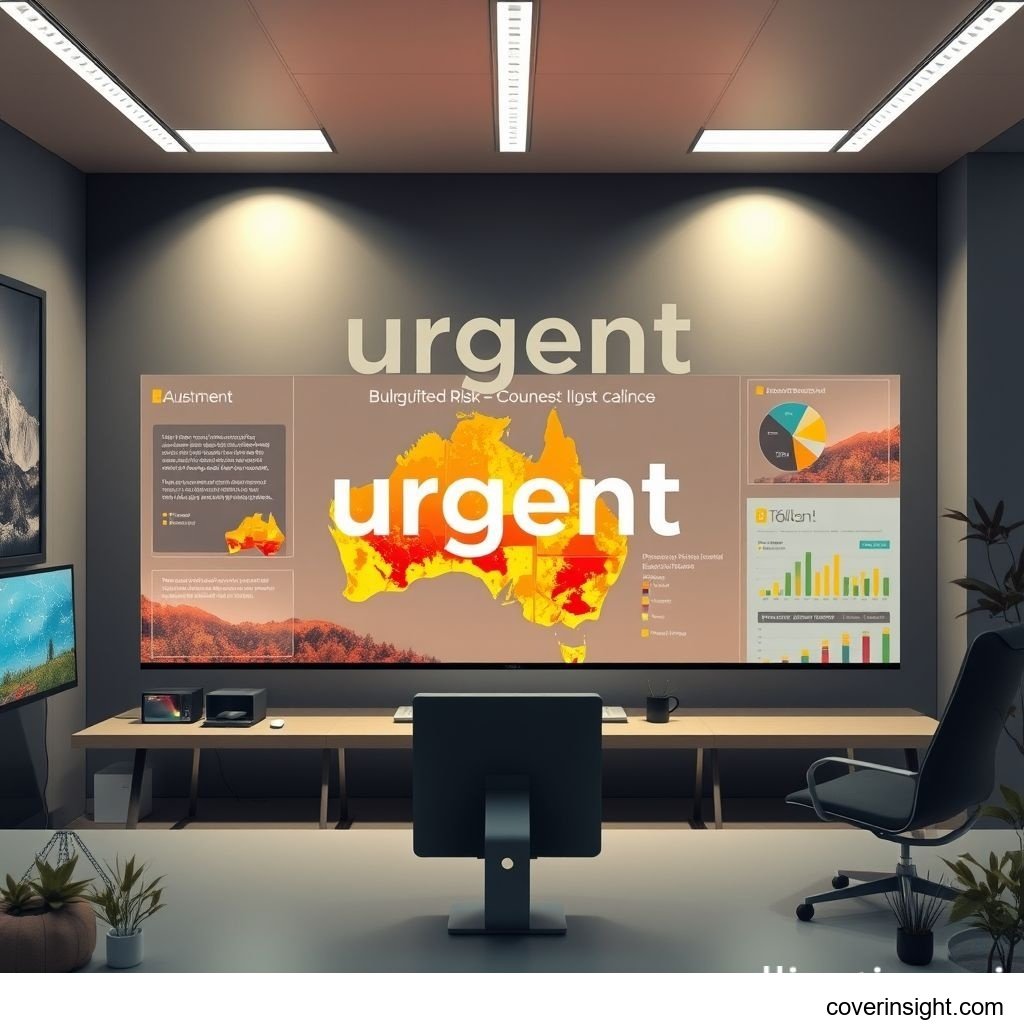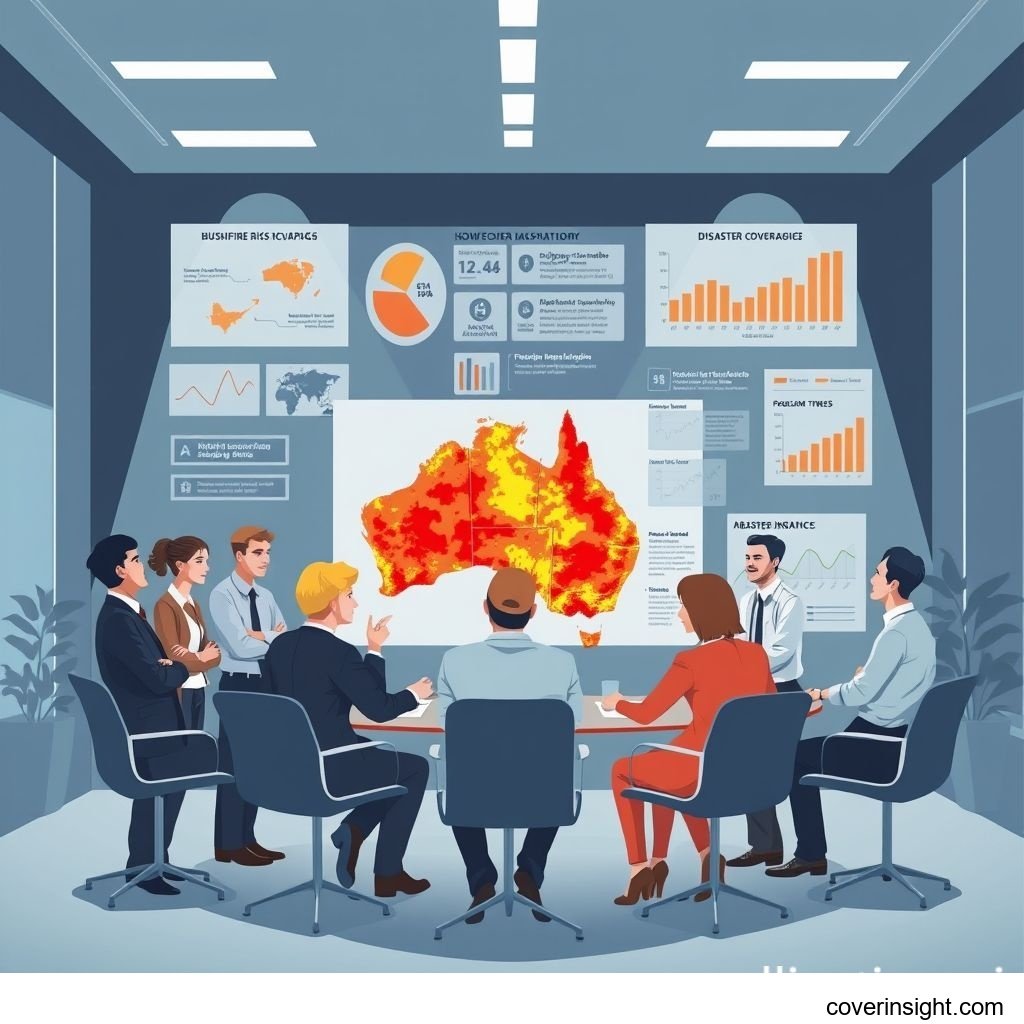Urgent: AU Bushfire Risk Mapping Changes Impact Home Cover 2025
The Australian landscape, with its unique flora and climate, has always been susceptible to bushfires. However, the increasing intensity and frequency of these events are prompting significant shifts in how risk is assessed and managed. A pivotal development on the horizon for 2025 involves comprehensive bushfire risk mapping changes that will directly impact home insurance coverage and premiums across the nation. Understanding these updates is crucial for Australian homeowners, as they will redefine how properties are evaluated for risk, potentially leading to adjustments in policy availability and cost.
Understanding the New Bushfire Risk Mapping Changes
Australia is on the cusp of implementing significant bushfire risk mapping changes set to redefine the landscape of home insurance by 2025. These revisions are driven by several factors, including the increasing frequency and intensity of bushfire events, advances in geospatial technology, and a deeper understanding of fire behaviour. The core objective is to provide more granular, accurate, and up-to-date risk assessments for individual properties and entire communities.
The Driving Forces Behind the Updates
The impetus for these bushfire risk mapping changes stems from the escalating financial and social toll of recent bushfire seasons. Insurers, government bodies, and emergency services are collaborating to develop more sophisticated models that factor in a broader range of variables than ever before. These include:
-
Advanced Topographical Analysis: Detailed elevation data, slope gradients, and aspect are critical in predicting fire spread.
-
Vegetation Fuel Load Assessment: More precise categorisation of different vegetation types, their density, and moisture content.
-
Weather Pattern Integration: Historical and predictive weather data, including wind speed, direction, temperature, and humidity, are now more heavily weighted.
-
Building Material and Construction Standards: Assessing the fire resistance of homes based on their construction type and materials.
-
Access and Egress Routes: Evaluating the safety and accessibility for emergency services and resident evacuation.
This integrated approach aims to move beyond broad hazard overlays to create highly specific risk profiles, which will naturally influence insurance underwriting processes. This detailed approach is also being used to refine methodologies that influence auto insurance rate changes, demonstrating a broader industry trend towards data-driven risk assessment.
How the New Maps Will Be Used
The new bushfire risk mapping changes will serve as a foundational tool for various stakeholders. For insurers, these maps will be integral to:
-
Premium Calculation: More accurate risk data allows for highly tailored premium pricing, reflecting the true exposure of a property.
-
Policy Underwriting: Insurers may use the maps to determine whether to offer coverage, or to identify specific conditions that must be met for a policy to be issued.
-
Risk Mitigation Advice: Providing homeowners with precise recommendations on how to reduce their bushfire risk, based on their property's specific profile.
-
Strategic Planning: Helping insurers manage their overall portfolio risk by identifying concentrations of high-risk properties.
Furthermore, these maps will be vital for local councils in land-use planning, for emergency services in strategic response planning, and for homeowners themselves in understanding and mitigating their personal risk.
Impact on Home Insurance Premiums
The introduction of new bushfire risk mapping changes for 2025 is set to usher in a new era for home insurance premiums, particularly for properties in or near bushfire-prone areas. While the ultimate goal is fairer pricing based on actual risk, this will inevitably lead to significant fluctuations for many homeowners.
Potential Premium Increases and Decreases
The primary effect of the updated mapping will be a re-evaluation of risk. For properties previously underestimated in terms of bushfire exposure, premiums are likely to increase, potentially substantially. Conversely, homes that were perhaps broadly categorised as high-risk under older, less precise maps might see their premiums decrease if the new data demonstrates a lower individual risk.
-
Higher Risk Areas: Properties located in areas with high fuel loads, complex topography, or limited access will likely face the steepest premium hikes. These are often rural or semi-rural areas, or those bordering national parks and state forests.
-
Lower Risk Areas: Urban fringes or areas with robust fire management plans and strategic buffer zones may see more stable, or even reduced, premiums.
It's important to note that these bushfire risk mapping changes aren't just about price. They're about reflecting the true cost of risk, which can encourage homeowners to invest in mitigation efforts. The industry-wide adoption of precise data, much like the factors driving auto insurance rate changes, signals a move towards highly individualised risk profiles.
Property Value Implications
Beyond insurance premiums, the detailed bushfire risk mapping changes could also influence property values. Homes identified as being in very high-risk categories might experience:
-
Decreased Buyer Interest: Potential buyers may be deterred by high ongoing insurance costs or perceived safety risks.
-
Stagnant or Declining Value: In extreme cases, properties could become uninsurable or prohibitively expensive to insure, significantly impacting their market value.
Conversely, properties in areas that are re-classified as lower risk or that have invested heavily in mitigation measures could see their appeal and value maintained or even enhanced. This evolving landscape underscores the importance of proactive engagement with risk assessment.
Coverage Details
Understanding what's included and what's typically excluded in home insurance policies, particularly in the context of bushfire risk mapping changes, is vital for homeowners. As risk assessments become more precise, policy terms and conditions may also evolve.
What’s Included
Standard home insurance policies in Australia generally provide coverage for damage to your property caused by fire, including bushfire. This typically extends to:
-
Structural Damage: Repair or rebuilding costs for your home's main structure (walls, roof, foundation).
-
Contents Coverage: Protection for your personal belongings inside the home (furniture, appliances, clothing). This is often an optional add-on or a separate component of the policy.
-
Temporary Accommodation: Costs for alternative housing if your home becomes uninhabitable due to bushfire damage.
-
Removal of Debris: Expenses incurred for clearing rubble and debris after a fire.
-
Emergency Services Access: Sometimes includes costs associated with ensuring emergency vehicle access to your property.
In light of the new bushfire risk mapping changes, some insurers may begin offering more specialised bushfire-specific clauses or add-ons that cater to the particular risks identified in the new maps, such as enhanced coverage for specific mitigation efforts or higher limits for certain types of damage. For comprehensive insights, homeowners should refer to resources like the AU Insurance Home page for detailed breakdowns.
Common Exclusions
While policies cover a broad range of fire damage, it's crucial to be aware of common exclusions that could leave you exposed:
-
Unoccupied Properties: If your home is left vacant for an extended period (e.g., 60 or 90 days, depending on the insurer) without prior notification, your coverage might be void.
-
Illegal Activities: Damage incurred while the property is used for illegal purposes.
-
Lack of Maintenance: Damage resulting from a homeowner's failure to maintain the property, which could exacerbate fire risk (e.g., not clearing overgrown vegetation).
-
Pre-Existing Damage: Damage that occurred before the policy was taken out or before the bushfire event.
-
Intentional Acts: Damage caused by deliberate acts of arson by the policyholder.
-
War or Terrorism: Acts of war or terrorism are typically excluded from standard policies.
As insurers leverage the new bushfire risk mapping changes to refine their offerings, it's possible that exclusions related to property preparation (e.g., failure to implement recommended mitigation strategies based on the new risk profile) could become more common or stricter. Homeowners are strongly advised to read their Product Disclosure Statement (PDS) carefully and ask their insurer for clarification on any ambiguous clauses.
Cost Analysis
The impending bushfire risk mapping changes for 2025 will undoubtedly reshape the cost landscape for home insurance. Understanding the various factors that influence premiums and knowing how to potentially reduce your costs will be key for homeowners navigating this evolving environment.
Price Factors
The price of your home insurance premium is a complex calculation influenced by numerous variables, which the new bushfire risk mapping changes will make even more precise. Key factors include:
-
Location: This is paramount. Properties in high-risk bushfire zones will naturally incur higher premiums. The new detailed maps will make this assessment far more granular.
-
Rebuilding Costs: The estimated cost to rebuild your home from scratch, considering construction materials, labour, and specific architectural features.
-
Construction Type: Homes built with fire-resistant materials (e.g., brick, concrete) may attract lower premiums than those made primarily of timber.
-
Age of Property: Older homes might have higher premiums due to outdated building standards or materials more susceptible to fire.
-
Home Security Features: Smoke detectors, fire alarms, and fire suppression systems can potentially reduce premiums.
-
Defensible Space and Mitigation Measures: Implementing bushfire-resistant landscaping, maintaining clear perimeters, and ensuring access for emergency services can positively impact your risk profile and, consequently, your premium.
-
Claims History: A history of multiple claims can lead to higher premiums.
-
Deductible/Excess: Choosing a higher excess (the amount you pay upfront in the event of a claim) typically lowers your annual premium.
-
Insurer's Underwriting Model: Each insurer has its own risk appetite and pricing strategy, which will now be heavily informed by the new bushfire risk mapping changes. This detailed data also supports broader fraud prevention initiatives across the insurance sector by providing clearer benchmarks for legitimate claims.
Saving Tips
While the bushfire risk mapping changes might introduce new challenges, there are proactive steps homeowners can take to potentially mitigate premium increases or even secure discounts:
-
Increase Your Excess: Opting for a higher excess will reduce your upfront premium, but ensure you can afford this amount if you need to make a claim.
-
Bundle Policies: Many insurers offer discounts for bundling home and car insurance policies.
-
Improve Property Fire Preparedness: This is perhaps the most impactful tip given the new mapping.
-
Create Defensible Space: Clear vegetation, prune trees, and manage fuel loads around your home.
-
Harden Your Home: Install fire-resistant shutters, seal gaps, ensure proper screening on vents, and consider using fire-resistant building materials if undertaking renovations.
-
Maintain Access: Ensure clear and accessible pathways for emergency vehicles.
-
Install Fire Safety Features: Smoke alarms are mandatory, but consider sprinklers or external dousing systems.
-
-
Review Your Policy Annually: As your circumstances change or the new bushfire risk mapping changes come into full effect, it's crucial to review your coverage. Don't just auto-renew; compare quotes from multiple insurers.
-
Accurate Sum Insured: Ensure you're not over-insuring (paying for more coverage than you need) or under-insuring (not having enough to rebuild). Use online calculators or professional valuers.
-
Ask for Discounts: Enquire about loyalty discounts, no-claims bonuses, or discounts for specific safety features.
By taking these steps, homeowners can proactively engage with the implications of the new bushfire risk mapping changes and potentially find ways to manage their insurance costs effectively. More general insurance advice can be found on Insurance Resources Global.
Navigating the New Landscape
The imminent bushfire risk mapping changes represent a significant shift in how property risk is understood and priced in Australia. For homeowners, adapting to this new landscape requires proactive engagement, informed decision-making, and a commitment to property preparedness. This evolution, alongside the general trend in auto insurance rate changes, signifies a more data-driven future for all insurance.
Homeowner Actions and Preparation
The most effective way for homeowners to navigate the implications of the new maps is through thorough preparation and risk mitigation.
-
Understand Your Property's New Risk Profile: Once the new maps are publicly accessible (or used by insurers), seek to understand how your specific property is classified. This knowledge is power. It will inform the necessary actions you need to take.
-
Implement Bushfire Mitigation Strategies:
-
Vegetation Management: Clear gutters, prune trees, remove flammable materials within 20 metres of your home. Create defendable spaces.
-
Home Hardening: Address vulnerabilities in your home's structure. This includes installing metal flyscreens on windows and doors, sealing gaps in external walls, installing fire-resistant curtains or shutters, and ensuring roof tiling is secure.
-
Water Supply: Ensure you have an independent water supply (e.g., tank) and a pump that can operate without mains power.
-
Emergency Plan: Develop and regularly practice a bushfire survival plan with your household, including clear trigger points for evacuation.
-
-
Engage with Local Authorities: Stay informed about local council bushfire management plans, community engagement programs, and any grants or assistance available for property upgrades.
-
Document Everything: Keep records of all mitigation work undertaken. Photos, receipts, and professional assessments can be invaluable proof to insurers that you are actively managing your risk. This level of detail also assists in broader fraud prevention initiatives by providing clear evidence of risk mitigation.
Choosing the Right Policy and Insurer
With the bushfire risk mapping changes influencing insurer approaches, the selection process for home insurance becomes even more critical.
-
Compare Quotes Thoroughly: Don't settle for the first quote. Obtain multiple quotes from different insurers. Some insurers may have a higher risk appetite for certain areas or better pricing models based on the new data.
-
Read the Product Disclosure Statement (PDS): This document is your contract. Pay close attention to sections on bushfire coverage, exclusions, claim processes, and any specific conditions related to high-risk areas.
-
Understand the Sum Insured: Ensure your 'sum insured' (the maximum amount your insurer will pay to rebuild your home and replace contents) is adequate. Consider demolition costs, professional fees, and temporary accommodation.
-
Check Insurer Reputation and Stability: Look into the insurer's claims handling reputation and financial strength. Resources like the Australian Prudential Regulation Authority or the Insurance Council of Australia can provide insights into industry standards and regulations.
-
Seek Professional Advice: Consider consulting with an independent insurance broker, especially if your property is in a high-risk area. They can help navigate complex policy options and advocate on your behalf.
By being well-informed and proactive, homeowners can better position themselves to secure appropriate and affordable coverage in the wake of Australia's significant bushfire risk mapping changes.
FAQs
The advent of detailed bushfire risk mapping changes inevitably raises numerous questions for homeowners across Australia. Here, we address some of the most common concerns.
How much does bushfire risk mapping changes cost?
The bushfire risk mapping changes themselves don't incur a direct cost to homeowners, as they are part of broader governmental and industry initiatives. However, the impact of these changes can lead to increased home insurance premiums for properties re-classified as higher risk. Conversely, some properties might see a decrease if their risk profile improves. The true 'cost' will be reflected in your annual insurance bill.
What affects premiums?
Home insurance premiums are influenced by a multitude of factors. Primarily, your property's location and its new bushfire risk classification under the bushfire risk mapping changes will be paramount. Other key factors include the cost to rebuild your home, construction materials, age of the property, your claims history, the level of excess you choose, and any fire mitigation measures you've implemented on your property.
Is it mandatory?
While home insurance itself is not legally mandatory in Australia (unlike auto insurance rate changes driven by compulsory third-party insurance), it is often a requirement for homeowners with a mortgage. Lenders typically insist on adequate home insurance to protect their investment. Given the escalating bushfire risk, having appropriate coverage, informed by the latest bushfire risk mapping changes, is highly advisable for all homeowners, irrespective of mortgage status.
How to choose?
Choosing the right home insurance policy requires careful consideration. Start by understanding your property's specific needs, especially in light of the new bushfire risk mapping changes. Compare quotes from multiple reputable insurers, paying close attention to the Product Disclosure Statement (PDS) for coverage specifics, exclusions, and conditions related to bushfire. Look for policies that offer robust bushfire cover, fair rebuild values, and clear terms regarding mitigation efforts. Considering the insurer's reputation for claims handling and their general approach to fraud prevention initiatives can also be beneficial.
Consequences of no coverage?
If you opt for no home insurance coverage, you bear the full financial responsibility for any damage to your property. In the event of a bushfire, this would mean covering the entire cost of rebuilding your home, replacing all your contents, and finding alternative accommodation out of your own pocket. This can amount to hundreds of thousands or even millions of dollars, leading to severe financial distress and potentially homelessness. For those with a mortgage, failing to maintain insurance is a breach of loan terms and can lead to default or other penalties from your lender.








Comments